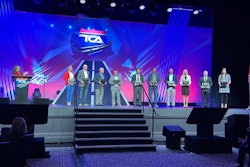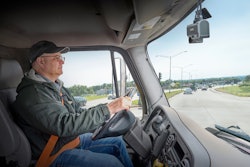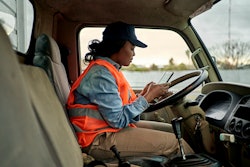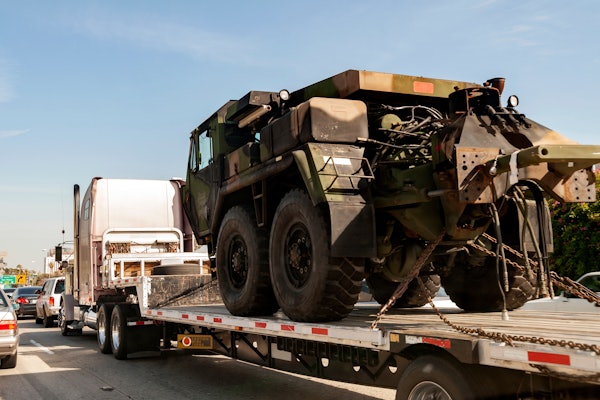Immersive learning, which involves creating authentic learning experiences through technology, is becoming increasingly popular. This type of training can improve driver safety and reduce liability for fleets.
Dr. Gina Anderson, CEO of Luma Bright Learnings, joins the 10-44 this week to explain how immersive learning can be used to familiarize drivers with specific locations, such as parking lots or terminals, before they arrive.
Contents of this video
00:00 10-44 intro
00:31 Immersive learning
01:20 How immersive learning works
03:35 Partnerships with shippers and carriers
06:21 Proactive approach
07:51 Driver safety and liability
09:54 Driver education
Jason Cannon (00:00):
This week's 10-44 is brought to you by Chevron Delo 600 ADF ultra low ash diesel engine oil. It's time to kick some ash. If you've got school-aged kids, you've seen firsthand how learning has evolved, and driver training is not immune. You're watching CCJ's 10-44, a weekly webisode that brings you the latest trucking industry news and updates from the editors of CCJ. Don't forget to subscribe and hit the bell for notifications, so you'll never miss an installment of 10-44.
Hey, everybody. Welcome back. I'm Jason Cannon. And my co-host, on the other side, is Matt Cole. When I was a kid, school was pretty black and white. You either knew the right answer or you didn't, and the grade at the top of the paper, whether it was good or it was bad, it reflected your level of comprehension. But through the years, we've seen how students are taught and how that's evolved, and in some cases, it's customized, given everyone's brain works just a little bit differently.
Matt Cole (00:54):
As we've transitioned to this day and age of everyone being remote, it stands to reason that sitting in a desk and being talked at has been de-emphasized, thanks to technology.
Jason Cannon (01:03):
Part of that shift in emphasis is embracing immersive learning, where students are thrown into an experience and you don't even have to be there. Dr. Gina Anderson, who's CEO of Luma Bright Learnings, she joins the 10-44 this week, and she tells us how it all works.
Dr. Gina Anderson (01:20):
So immersive learning, it's like an authentic learning environment where you're in the actual, or you get to experience the actual environment that you need to know the information. So when you think about the Google, think about Google Map, where you take the person and you drop them in the map and you can look around the environment. It's giving someone the experience of doing that without the technology of the three-dimensional set. So virtual reality is putting on technology, so that you can experience it. But you need that component or you need the technology component. With immersive learning, you can create those experiences pretty easily through the technology that exists today. And what that provides the actual driver is an experience that they're going to have or that they have had to reinforce that information. A good example is drivers who have to go to, let's say, downtown Chicago, and they have to go to a grocery store and they have to drop a load.
(02:28):
If they've never been to that store, they don't know what that parking lot looks like. They pull in, and they hit the bolo. They could have trained with a trainer for eight months or however long, three months, and they've never been to that store. They go there, they park, "Oh no, I didn't see the bolo," and they hit it. But if that store would've created an immersive learning experience, they've gone out, they've taken their phone, they've scanned the environment, they've loaded it, they've identified the bolo, they've labeled the store number, they send that out to the driver.
(03:01):
They get that before they go to the store. They know what to expect before they get there. That's immersing them in that experience, so they know what to expect. So people are using this for parking lots. They're using it for terminals. If they've never been to a terminal, where to drop their keys. For cargo securement, for inspections of their trucks. It's really bringing in the authentic learning experience for the driver. It's not generic. You're not just learning about parking on a generic video. You're actually learning about parking in the environment you need.
Matt Cole (03:35):
Fleets have hundreds and thousands of trucks and nearly as many customers scattered all over the U.S. Who has time to go out and scout all these locations? Gina says, in most cases, this is a partnership with a shipper or receiver who is more than willing to help out, because in the end, they too stand to benefit.
Dr. Gina Anderson (03:51):
You don't have to do the work. You have people at those locations or your customers are there. We train them on how to do the scan. Everyone knows how pretty much how to take a panoram on their phone, so they have to take a panoram of the parking lot or the environment. And so, we worked with a client that has over 250 stores. They didn't go to every 250 store. There are individuals at every location that know how to take a panoram picture, and so, they load their panoram pictures. And then, most of these locations have a paper. They have a piece of paper that says, "This store, this information." It's all on a piece of paper. They already have the content. They just aren't using it in a way that is efficient and can save time on demand in real time. So it's about helping them get this information that's on a piece of paper about that store and about the dangers on that parking lot in an actual environment that's going to be easy for the drivers to use and access.
Jason Cannon (04:57):
There is an element of proactiveness here. You don't know what you don't know. So drivers and driver managers have to be proactive in understanding, "Hey, we've never been here before, so let's make sure this looks like we expect it to look." Gina tells us more after a word from 10-44 sponsor, Chevron Lubricants. Protecting your diesel engine and its after treatment system has traditionally been a double-edged sword. The same engine oil that is so essential to protecting your engine's internal parts is also responsible for 90% of the ash that is clogging up your DPF and upping your fuel and maintenance costs. Outdated industry thinking still sees a trade-off between engine and emission system protection, and Chevron was tired of it.
(05:36):
So they spent a decade of R&D developing a no compromise formulation. Chevron Lubricants developed a new ultra low ash diesel engine oil that is specifically designed to combat DPF ash clogging. Delo 600 ADF with OMNIMAX technology cuts sulfate ash by a whopping 60%, which reduces the rate of DPF clogging and extends DPF service life by two and a half times. And just think what you can do with all the MPGs you're going to add from cutting your number of regens. But Delo's 600 ADF isn't just about after treatment. It provides complete protection extending drain intervals by preventing oil breakdown. Before, you had to choose between protecting your engine or your after treatment system, and now, you don't. 600 ADF from Delo with OMNIMAX technology, it's time to kick some ash.
Dr. Gina Anderson (06:22):
So if you're going to a store, you're able to be able to get that information. So in our LMS, all the stores, the managers have them all labeled. If you're going to that store, you would be able to go into your phone, search that store, and pull it up that night before you go there. So those stores are all labeled and released, so you can go in. Now, you as a driver would have to have, if it's not directly assigned to you, if your manager didn't assign it to you, you would have to have the motivation to want to know what that store looks like. If you're going to ignore it and nobody assigned it to you, but really what people are doing, what our clients are doing is they are assigning those stores. So you know, once you get that load assignment, that's part of your information on that store.
(07:12):
So it's not in a book and you got to go through and look through a book of information. You actually see and experience it. The driver's feedback on this is very positive actually, because it all can translate to their language in real time. Any information can be translated to their original language, and as you know, you learn best in the language that is yours. So the drivers rate them really high, because they really appreciate knowing what they're getting into. It's like, "Oh my gosh, this carrier really cares about me and really wants me to know what I'm getting into." If they have questions, then they can message and get real time information about that.
Matt Cole (07:51):
This type of immersive learning solves two problems, driver safety and liability, because the fleet is the one that's going to be responsible for a driver crashing into something on site.
Dr. Gina Anderson (08:00):
I think the carrier is concerned about, obviously, the cost, the rising cost of the accidents, the risk that it would be if somebody doesn't secure their cargo exactly right. Goodness, grief, I've seen some of the general information, we really have to build authentic experiences for the drivers that are meaningful. It's one thing to learn generally about cargo securement. It's another thing to go out with a trainer and have them show you, but the average learner isn't going to remember that. Unless they're experienced and they've done it a lot of times, they're still going to, if they get a new vehicle or they have a new experience, they have to be reinforced that information. So yeah, definitely a liability sense. If they don't have that secure, even though they've shown them, this gives them an opportunity to reinforce that information. So I think it's both.
(08:52):
I don't think you can say it's one or the other. I also think it gives you an opportunity to connect from a recruitment standpoint and build those connections. It's one thing to send out generic information. It's another thing to give an adult information what they need when they need it. And not every carrier, obviously, is doing this. They're still doing the same thing that you described originally. And drivers really do rate this high. They have the opportunity after every eNugget to rate them, and they do rate it high. And I think it's because, number one, they have the information, but they appreciate it. They leave us feedback, real-time feedback, that they appreciate that the carrier is doing this for them. And so, I think that says a lot from a driver perspective. It would be interesting to ask drivers themselves, "Is this good for your safety?" Yeah, absolutely. But it also shows that the carriers have some stake in really caring about the driver.
Jason Cannon (09:54):
The key to driver education and any type of education really is to ensure that the information that you're sharing is relevant and that you're not just slinging a bunch of information and stats around in the name of education.
Dr. Gina Anderson (10:06):
It's really important that you provide experiences for the drivers that are meaningful, because as adult learners in general, your attention spans are really shrinking, especially with the YouTube generation and TikTok. The learning scientists are studying the brain and attention to information, and it is documented in the research that our attentions and our neurons are really having shortened attention. So if you have limited attention for the learners, you have to focus it on information that they need when they need it. It's critical. It's critical. That's really...
Jason Cannon (10:46):
That's it for this week's 10-44. You can read more on CCJDigital.com. While you're there, sign up for our newsletter and stay up to date on the latest in trucking industry news and trends. If you have any questions or feedback, please let us know in the comments below. Don't forget to subscribe and hit the bell for notifications, so you can catch us again next week.











